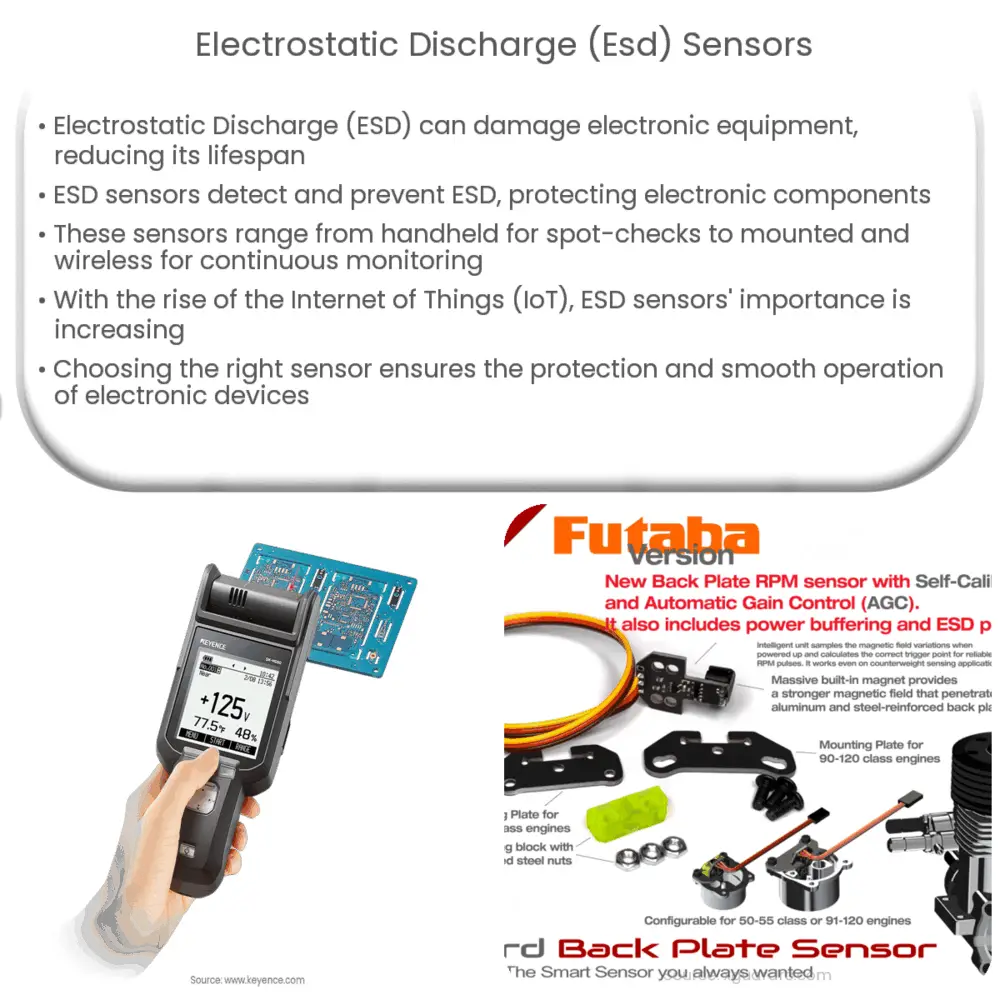Explore the significance of Electrostatic Discharge (ESD) Sensors in protecting electronic devices, their types, and applications in various industries.

Understanding Electrostatic Discharge (ESD) Sensors
Electrostatic Discharge, commonly referred to as ESD, is a sudden and momentary electric current that flows between two objects at different electrical potentials. The occurrence of ESD can cause substantial damage to electronic equipment, often leading to catastrophic failure or a significant reduction in its operational life. Therefore, the need for ESD sensors has become increasingly crucial in many industries, especially in the electronics manufacturing sector. These sensors help in the detection and prevention of ESD, safeguarding sensitive electronic components and systems.
Working Mechanism of ESD Sensors
ESD sensors are designed to monitor electrostatic discharges in the surrounding environment. They work on the principle of electric field detection, where they measure the electrical charge in the air and trigger an alarm if the detected charge exceeds a certain threshold level. This early warning system allows for the implementation of preventive measures before the discharge occurs, thus protecting sensitive devices from damage.
The Importance of ESD Sensors
Electrostatic discharge can be extremely damaging to electronic components and systems. It has the potential to cause immediate hardware failure, data corruption, or latent damage that may degrade performance over time. Therefore, having a reliable ESD detection system is an integral part of any environment where sensitive electronics are manufactured, used, or stored.
Types of ESD Sensors
-
Handheld ESD Sensors: These are portable sensors that are usually used for spot-checking potential ESD risks in various locations. They are practical, user-friendly, and provide immediate readings.
-
Mounted ESD Sensors: These sensors are permanently installed in a specific location, continuously monitoring for any electrostatic discharges. They are often networked with other sensors and central monitoring systems for comprehensive area coverage.
-
Wireless ESD Sensors: These sensors offer the same functionality as mounted sensors but with the added convenience of wireless connectivity. This feature allows for more flexible installation options and the ability to monitor areas that are difficult to wire.
The Role of ESD Sensors in the Internet of Things (IoT)
The proliferation of IoT devices in our daily lives has amplified the importance of ESD protection. Given their connectivity and ubiquity, a single ESD event could potentially disrupt an entire network of devices. Here, ESD sensors play a critical role in safeguarding these networks, ensuring the seamless operation of our interconnected world.
Advanced ESD Sensor Technology
As technology advances, so do ESD sensors. Modern sensors are now being designed with smart features, such as the ability to communicate with other devices on a network, and automated control mechanisms to enact safety protocols when a potential ESD event is detected. Furthermore, some sensors have integrated data logging features that track and store ESD event history. This data is invaluable for troubleshooting and continuous process improvement in the manufacturing environment.
ESD Sensor Applications
-
Electronics Manufacturing: In production lines for electronic components and devices, ESD sensors play a vital role in preventing damage to sensitive components and maintaining the quality of the end product.
-
Data Centers: With vast arrays of servers and other networking equipment, data centers utilize ESD sensors to protect their hardware from electrostatic discharges.
-
Medical Equipment: The high cost and critical function of medical equipment necessitate the use of ESD sensors to prevent equipment failure due to ESD events.
-
Automotive Industry: With an increasing amount of electronics in modern vehicles, ESD sensors are used to protect these components during manufacturing and maintenance processes.
Selection Criteria for ESD Sensors
When selecting an ESD sensor, it’s important to consider a few key factors: the sensitivity of the sensor, the response time, the type and complexity of the system being protected, and the environmental conditions in which the sensor will be installed. The ideal ESD sensor should be capable of accurately detecting potential ESD events in its assigned location and should be compatible with the devices or systems it is intended to protect.
Conclusion
In conclusion, Electrostatic Discharge (ESD) sensors are an essential tool in today’s electronics-dominated world. They protect sensitive electronic equipment from potentially catastrophic electrostatic discharges, ensuring reliability and longevity of these devices. From handheld sensors for spot-checking to mounted and wireless sensors for continuous monitoring, ESD sensors come in various types to suit different applications. As the Internet of Things (IoT) continues to expand, the importance of these sensors is set to grow exponentially. The key is to choose a sensor that fits the specific needs and conditions of your operation, thereby ensuring the seamless operation of your electronic devices and networks.

